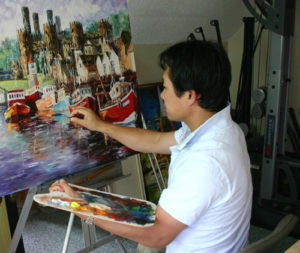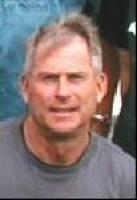 Daniel Wall is the innovator behind Intense Impressionism, a contemporary style that brings the Impressionist art movement from the 1800s into the modern era with vivid colors, heavy textures, and messages of joy and love.
Daniel Wall is the innovator behind Intense Impressionism, a contemporary style that brings the Impressionist art movement from the 1800s into the modern era with vivid colors, heavy textures, and messages of joy and love.
From his subjects to his techniques, every aspect of Wall’s works has an optimistic meaning behind it, which he reinforces with each stroke of his palette knife. Drawing on his passion for art that began in early childhood, Wall creates expressive landscapes, cityscapes, and floral paintings that appeal to art lovers across the globe.
Daniel Wall: Personal History
Born in a small village in northern China in 1965, Daniel Wall began drawing and painting at the young age of 4. Crayons were a rarity in his household, so Wall’s aunt, an elementary school teacher, brought home chalk and pencils for Wall to use. His mother, a talented self-taught artist, also encouraged Wall’s interest in art.
Wall took every opportunity to draw or paint after school, earning numerous art awards in his youth. At 16 years old, Wall received a government scholarship to study art at Laiyang Teachers College, an academy that only accepts a handful of students every year.
Following his graduation in 1983, Wall worked as a full-time art professor in the Teacher’s College in his hometown, and later furthered his education by graduating from Shandong University of Arts in 1987. After graduating, Wall worked as an illustrator and fine art editor for the “Fire Fighter Journal” of Shandong Province.
Birth of Intense Impressionism
Soon after he began teaching, Wall became fascinated by Impressionism and one of its founders, Claude Monet. While teaching about Monet to his students, Wall would sometimes duplicate a painting by Monet many times to better understand the artist’s techniques. During that time, Wall realized that the moderate colors and textures in Impressionist paintings could only realistically depict light. Wall desired for the colors to be more vibrant and the texture to be stronger to reflect the excitement, fast-paced, and high intensity of modern life.
One day in 1984, Wall decided to adapt the unique Chinese “Dry-Brush” calligraphy and painting technique, using a palette knife to apply additional colors to some of his oil paintings to enhance their intensity. When his family and friends were amazed by these paintings, Wall realized he discovered something special. He continued to use palette knives and hone his style, and in the process, Intense Impressionism was born.
Coming to America
In 1995, Daniel Wall and his wife immigrated to the United States to further their education. Wall earned a Master’s Degree in mathematics with computer science concentration from Georgia Southern University, but instead of pursuing a career in this field, Wall followed his lifelong passion and became a full-time artist.
Wall resided in Florida to draw inspiration from its ocean scenes and tropical landscapes, though he left briefly to study fine art in Italy for three months. Later, he returned to Italy multiple times to draw further inspiration from the country’s architecture and culture. His artistic development was solidified through his extensive experience as an art professor, illustrator, and art editor. In 2000, Wall began featuring his artwork on auction television shows, resulting in a national following.
In 2006, Wall, his wife, and their 6-year-old son moved to North Carolina. Wall paints full time while his wife works as a professor at East Carolina University. In 2007, they welcomed a daughter to their family.
Wall continues to reside in North Carolina, and his paintings are widely collected in the United States and around the world.
Daniel Wall: Style and Influences
Wall describes his work as Intense Impressionism, his own modern-day interpretation of the style Impressionists made famous in the 19th century. Intense Impressionism is characterized by large, conspicuous strokes, heavy textures formed by thick impasto, and an exaggerated emphasis on light.
All of Wall’s artwork is created exclusively with a palette knife. Even the smallest details are applied with the tips or edges of palette knives instead of brushes. Wall prefers palette knives for their ability to apply thick swathes of bright oil paint onto the canvas.
Wall is heavily influenced by the Impressionists, principally Monet, but also by Camille Pissarro, Alfred Sisley, and Georges Seurat. His strategy of allowing his strokes to be fully evident—while also imbuing his pigment applications with an Expressionist energy—reinvigorates the Impressionist style, allowing Wall to find his own unique artistic approach.
Wall is adept at juxtaposing color to create striking contrasts and dramatic effects. At first glance, his combinations of colors—with their warm and cool, dark and light contrasts—may appear spontaneous, but further viewing reveals his dedication to a fixed light source, bringing his compositions into focus.
Wall attaches specific meanings to certain elements in his art. He describes light as a representation of hope, the open sky as freedom, a road as the path of life, and water as emotion. Even his thick impasto represents what he calls “strong and powerful love.” All of his symbolism points toward his own romantic and joyful view of life.
“I use different colors and different shaped trees to make my paintings colorful and beautiful to inspire people to appreciate the beauty of life,” Wall says. “I want the bright colors to inspire people to feel that every day is a good day.”
Daniel Wall: Accomplishments
- Wall served as a journal illustrator and cover designer for more than 20 national journals, and has published over 500 book covers and illustrations. His works were voted “Best in Art” by Absolute Art in 2013 and 2015.
- Wall’s artworks were widely collected by many corporations and celebrities, and have been used in Hallmark movies.
- Wall won a number of fine art awards throughout his career, some of which include: First Place in Youth Fine Art Competition in the City of Laixi in 1981, the Best Work Award from Shandong News Artists Association in 1990, the Best Book Award from China National Fire Control Association in 1990, the Best Illustration award from Shandong Insurance Magazine in 1991, the Excellent Work Award in Starke Art Festival in 1999.


 Michael Atkinson born in Texas in 1946. He started painting as a child in the northwest Texas town of Lubbock. Attracted early to the study of architecture, he earned a degree from Texas Tech University, then taught and worked in the field for a time. He soon realized that he was most drawn to the design and presentation aspects of his profession. In the summer of 1974, he took time off to concentrate on his painting.
Michael Atkinson born in Texas in 1946. He started painting as a child in the northwest Texas town of Lubbock. Attracted early to the study of architecture, he earned a degree from Texas Tech University, then taught and worked in the field for a time. He soon realized that he was most drawn to the design and presentation aspects of his profession. In the summer of 1974, he took time off to concentrate on his painting.